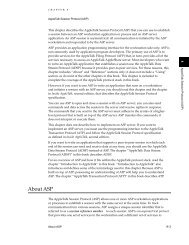URL Loading System Programming Guide - Apple Developer
URL Loading System Programming Guide - Apple Developer
URL Loading System Programming Guide - Apple Developer
You also want an ePaper? Increase the reach of your titles
YUMPU automatically turns print PDFs into web optimized ePapers that Google loves.
About the <strong>URL</strong> <strong>Loading</strong> <strong>System</strong><br />
How to Use This Document<br />
Relevant Chapter: “Cookies and Custom Protocols” (page 62)<br />
How to Use This Document<br />
This document is largely divided based on which <strong>URL</strong> loading class the chapter describes. To decide which API<br />
to use, read “<strong>URL</strong> <strong>Loading</strong>” (page 8). After you decide which API you want to use, read the appropriate<br />
API-specific chapter or chapters:<br />
●<br />
●<br />
●<br />
For using the NS<strong>URL</strong>Session class to asynchronously fetch the contents of a <strong>URL</strong> to memory or download<br />
files to disk, read “Using NS<strong>URL</strong>Session” (page 15). Then read “Life Cycle of a <strong>URL</strong> Session” (page 64) to<br />
learn in detail how NS<strong>URL</strong>Session interacts with its delegates.<br />
For using NS<strong>URL</strong>Connection to asynchronously fetch the contents of a <strong>URL</strong> to memory, read “Using<br />
NS<strong>URL</strong>Connection” (page 32).<br />
For using NS<strong>URL</strong>Download to download files asynchronously to disk, read “Using NS<strong>URL</strong>Download” (page<br />
40).<br />
After reading one or more of these API-specific chapters, you should also read the following chapters, which<br />
are relevant to all three APIs:<br />
●<br />
●<br />
●<br />
●<br />
●<br />
“Encoding <strong>URL</strong> Data” (page 48) explains how to encode arbitrary strings to make them safe for use in a<br />
<strong>URL</strong>.<br />
“Handling Redirects and Other Request Changes” (page 50) describes the options you have for responding<br />
to a change to your <strong>URL</strong> request.<br />
“Authentication Challenges and TLS Chain Validation” (page 53) describes the process for authenticating<br />
your connection against a secure server.<br />
“Understanding Cache Access” (page 58) describes how a connection uses the cache during a request.<br />
“Cookies and Custom Protocols” (page 62) explains the classes available for managing cookie storage and<br />
supporting custom application-layer protocols.<br />
See Also<br />
The following sample code is available:<br />
●<br />
LinkedImageFetcher (OS X) and Advanced<strong>URL</strong>Connections (iOS) use NS<strong>URL</strong>Connection with custom<br />
authentication.<br />
2013-10-22 | Copyright © 2003, 2013 <strong>Apple</strong> Inc. All Rights Reserved.<br />
13
















